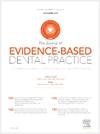口内照相机和智能手机在儿童早期龋齿检测中的比较:诊断准确性研究
IF 4
4区 医学
Q1 DENTISTRY, ORAL SURGERY & MEDICINE
引用次数: 0
摘要
目标儿童早期龋齿(ECC)是影响全球儿童的一个主要公共卫生问题。远程牙科为ECC检测提供了创新方法,尤其是在医疗条件有限的地区。本研究比较了口内照相机和智能手机与视觉临床检查在检测 ECC 方面的准确性。方法在埃及亚历山大附近的一个农村地区开展了一项前瞻性诊断准确性研究,涉及 6 岁以下儿童。在将儿童随机分为两组后,口内照相机(C50 全高清荧光照相机)或智能手机(三星 Galaxy A24)捕捉口内结构。参考标准是在日光下进行目测临床检查,无需放大或烘干。根据临床检查、口内相机视频和智能手机照片,采用龋齿评估谱和治疗(CAST)指数标准对牙齿进行分类。在3个阈值(釉质龋、牙本质龋和釉质/牙本质合并龋)下,计算了2种方法的敏感性、特异性和准确性。口内照相机和智能手机在 3 个阈值下均具有较高的特异性和准确性(≥90%)。结论:口内照相机比智能手机更准确地检测出龋齿。尽管如此,两种设备在所有诊断阈值下都表现出较高的特异性和准确性。在服务不足的地区,智能手机是口内照相机的良好替代品,可改善ECC的检测和护理。本文章由计算机程序翻译,如有差异,请以英文原文为准。
COMPARISON OF INTRAORAL CAMERAS AND SMARTPHONES IN EARLY CHILDHOOD CARIES DETECTION: A DIAGNOSTIC ACCURACY STUDY
Objectives
Early Childhood Caries (ECC) is a major public health problem affecting children worldwide. Teledentistry offers innovative approaches for ECC detection, particularly in areas with limited access to care. This study compared the accuracy of intraoral cameras and smartphones in relation to visual clinical examination in detecting ECC.
Methods
A prospective diagnostic accuracy study was conducted in a rural area near Alexandria, Egypt, involving children under 6 years old. An intraoral camera (C50 Full HD with fluorescence) or a smartphone (Samsung Galaxy A24) captured intraoral structures after randomizing the children into 2 groups. The reference standard was visual clinical examination under daylight without magnification or drying. Teeth were categorized using the Caries Assessment Spectrum and Treatment (CAST) index criteria based on clinical examination, intraoral camera videos and smartphone photos. Sensitivity, specificity, and accuracy were calculated for the 2 methods at 3 thresholds: enamel caries, dentin caries and enamel/dentin caries combined.
Results
The study included 116 children, mean (SD) age = 4.3 (1.0) years, 83.6% with untreated decay and mean (SD) number of decayed teeth = 4.03 (3.50). Both the intraoral camera and the smartphone had high specificity and accuracy at the 3 thresholds (≥90%). The lowest sensitivity was in the case of detecting enamel lesion (intraoral camera = 77.5% and smartphone = 68.5%).
Conclusion
Enamel caries was detected by the intraoral camera more accurately than the smartphone. Despite this, both devices exhibited high specificity and accuracy at all diagnostic thresholds. Smartphones present a good alternative for intraoral cameras in underserved areas, improving ECC detection and care.
求助全文
通过发布文献求助,成功后即可免费获取论文全文。
去求助
来源期刊

Journal of Evidence-Based Dental Practice
DENTISTRY, ORAL SURGERY & MEDICINE-
CiteScore
6.00
自引率
16.70%
发文量
105
审稿时长
28 days
期刊介绍:
The Journal of Evidence-Based Dental Practice presents timely original articles, as well as reviews of articles on the results and outcomes of clinical procedures and treatment. The Journal advocates the use or rejection of a procedure based on solid, clinical evidence found in literature. The Journal''s dynamic operating principles are explicitness in process and objectives, publication of the highest-quality reviews and original articles, and an emphasis on objectivity.
 求助内容:
求助内容: 应助结果提醒方式:
应助结果提醒方式:


